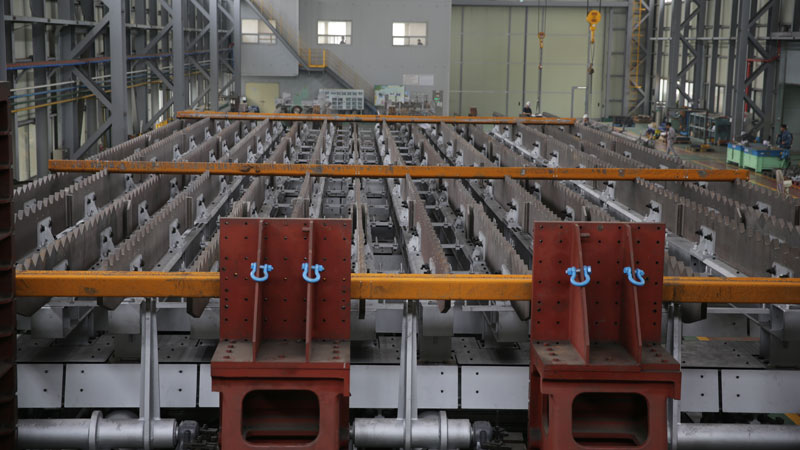Cooling Beds in Steel Manufacturing: Enhancing Efficiency and Quality
In the bustling world of steel manufacturing, where precision and quality reign supreme, every step in the process counts. One such crucial element often overlooked but immensely vital is the cooling bed. Cooling beds play a pivotal role in the steel production line, ensuring the integrity, durability, and quality of the final product. Let’s delve into the nuances of cooling beds, exploring their types, functions, advantages, challenges, and innovations, painting a comprehensive picture of their significance in the steel industry.
Types of Cooling Beds
Cooling beds come in various forms, tailored to specific manufacturing needs. Walking beam cooling beds, chain transfer cooling beds, and skid transfer cooling beds are the most common types. Each type employs distinct mechanisms to facilitate the cooling process, ensuring that steel products achieve the desired quality standards.
Functioning of Cooling Beds
The functioning of cooling beds revolves around a fundamental principle: controlled cooling. As freshly produced steel products move along the production line, they pass through cooling beds, where intense heat from the manufacturing process is dissipated. This controlled cooling not only prevents warping and cracking but also imparts the required surface quality and dimensional accuracy to the steel products.
Advantages of Cooling Beds
Cooling beds offer a multitude of advantages in steel manufacturing. By efficiently managing the cooling process, these beds significantly reduce the occurrence of warping and enhance the overall surface quality of steel products. Moreover, they play a pivotal role in ensuring dimensional accuracy, a crucial factor in various applications where precision matters.
Challenges and Solutions
Despite their pivotal role, cooling beds face challenges, particularly concerning overheating. However, with the integration of advanced cooling technologies, these challenges are being effectively addressed. Implementations such as automated cooling control and real-time monitoring have revolutionized the cooling bed landscape, ensuring seamless operations even in the face of challenging manufacturing scenarios.
Significance in Different Steel Products
Cooling beds are not one-size-fits-all entities; their significance varies concerning the type of steel products being manufactured. In the realm of long steel products like bars and rods, cooling beds aid in maintaining straightness and consistency. Similarly, for flat steel products like sheets and plates, cooling beds ensure a smooth surface finish and prevent deformation.
Innovations in Cooling Bed Technologies
The future of cooling beds is illuminated by cutting-edge innovations. Automation and robotics are becoming integral parts of cooling bed setups, streamlining the process and enhancing efficiency. Additionally, the integration of the Internet of Things (IoT) and data analytics enables real-time monitoring, predictive maintenance, and data-driven decision-making, leading to unparalleled levels of precision and control.
Sustainability and Environmental Impact
In the modern industrial landscape, sustainability is not just a buzzword; it’s a necessity. Cooling beds are no exception. With a focus on energy efficiency and the implementation of eco-friendly cooling methods, the steel industry is not only enhancing its production but also contributing positively to the environment.
Conclusion
In the intricate dance of steel production, cooling beds emerge as unsung heroes, ensuring that the final products meet the stringent demands of quality and precision. As technology continues to advance, these beds are evolving, becoming smarter, more efficient, and environmentally conscious. With their significance extending across various steel products, cooling beds are at the heart of the steel manufacturing revolution.
Frequently Asked Questions
- What is the primary function of a cooling bed in steel manufacturing?
The primary function of a cooling bed is to dissipate the intense heat generated during the steel manufacturing process, preventing warping, enhancing surface quality, and ensuring dimensional accuracy of steel products. - How does a walking beam cooling bed differ from a chain transfer cooling bed?
Walking beam cooling beds use a walking beam mechanism to move steel products, whereas chain transfer cooling beds utilize a chain-driven system for the same purpose. The choice between the two depends on the specific requirements of the manufacturing process. - Are there eco-friendly cooling methods implemented in modern cooling beds?
Yes, modern cooling beds often incorporate water-based cooling methods, which are more environmentally friendly compared to traditional methods. These methods efficiently dissipate heat while minimizing water consumption. - Can cooling beds prevent all types of warping in steel products?
While cooling beds significantly reduce warping, they might not prevent it entirely. However, by employing precise cooling methods and advanced technologies, manufacturers can minimize warping to a great extent. - What are the potential future advancements in cooling bed technologies?
Future advancements in cooling bed technologies include further automation, integration of artificial intelligence for predictive maintenance, and the development of innovative cooling mediums to enhance efficiency and reduce environmental impact.
Custom Message:
Thank you for exploring the fascinating world of cooling beds in steel manufacturing with us. Stay tuned for more insightful articles on industrial innovations and technological advancements.


